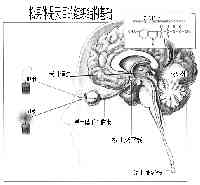松果體(天目)分泌的美樂托寧對健康的影響
-------- 《轉法輪》
現代科學家將松果體直接叫做「第三隻眼」(1)。人們直到1950年發現了松果體激素-美樂托寧後才對其功能有所了解。最近,我們發現在大法弟子唾液中美樂托寧的水平增高。我們這一發現和當今科學新進展有助於解釋法輪大法修煉中的一些現象。例如為甚麼修煉者能保持身體健康,為甚麼他們會有在煉功時能看見另外空間景象這一類的特殊功能。這篇小綜述總結了近年來有關人體美樂托寧和松果體的知識和其臨床應用。
松果體是一個神秘的器官, 三百年前法國哲學家雷諾.底卡地斯將之描述為「靈魂的座椅」。現在已經很清楚地知道松果體調解所有的內分泌器官的功能而被稱為「內分泌器官總司令」。《轉法輪》一書中指出,松果體是天目的基礎(圖1),松果體在維持健康中,對環境壓力產生適應性反應, 這是通過人體,生命和宇宙的相互作用實現的。因此,松果體被認為是至關重要的器官(2)。
美樂托寧的合成是通過光節律在轉譯水平上調解的。合成出的美樂托寧可調解情緒,睡眠,性行為,繁殖,免疫系統和生理節奏(3)。美樂托寧是通過高親和力的受體完成這些調節功能的。這些受體屬於與G蛋白相聯繫的,具有七次穿膜結構的受體,存在於眼,腎,胃腸道。血管和腦(4)。另有證據表明美樂托寧在衰老及與衰老相關的疾病中的作用。這可能與其有效地消除自由基(或抗氧化)能力有關(5,6)。美樂托寧作為抗氧化劑的潛在臨床意義是巨大的。它可能對治療許多病理生理疾病狀態有效。能用它治療的包括各種癌症,高血壓,肺部疾患和諸如老年性痴呆的各種神經退行性病變(3,7-9)。此外,有報導美樂托寧對免疫系統缺陷小鼠有免疫調節功能,提示我們它可能改善免疫狀況(11-12)。
眾所周知,修煉法輪大法能使人保持健康並能使諸如神經緊張,癌症,白血病,自身免疫病,失眠這一類的疾病痊癒。此外,煉法輪功也能逆轉衰老過程。可以推測,由松果體分泌的美樂托寧水平變化可能是對法輪功調節健康的原理之一。
衰老,失眠,和乳腺癌是絕經期婦女的主要疾病。美樂托寧可能與絕經期相關過程如乳腺癌和衰老有關。儘管美樂托寧替代療法治療所有絕經期婦女仍未能通過,但有證據表明美樂托寧確能改善更年期婦女綜合症 (13)。在絕經期婦女開始煉法輪功後恢復月經是司空見慣的。可以進一步推測,內源性美樂托寧的增加有可能導致絕經期婦女練功後恢復了月經。
隨著人的衰老,夜間血清中美樂托寧濃度及其生理效應降低。有些研究人員提出美樂托寧對衰老相關疾病有作用(14,15)。雖然尚無證據表明美樂托寧在人體的抗衰老效應,在小鼠和大鼠身上做的實驗表明松果體可能是掌管衰老的內源性時鐘(16-17)。有臨床證據表明美樂托寧在諸如生物時鐘節奏,睡眠,情緒也許還包括繁殖,腫瘤生長和衰老方面有生物調節作用(3)。儘管如此,有些科學家表示,美樂托寧對人體生理和病理生理的作用仍待近一步確定(18)。
綜上所述,很有必要對在法輪大法修煉者身上觀察到的與健康相關的現象及美樂托寧在其中所起的作用進行深入的研究。
參考文獻:
1. Booth, F. M. 1987. The human pineal gland: a review of the "third eye" and the effect of light. Aust N Z J Ophthalmol 15:329.
2. Pettersson, P. 2000. The pineal gland - The bridge between the physical and spiritual reality. http://www.alphaomega.se/english/pineal.html.
3. Brzezinski, A. 1997. Melatonin in humans. N Engl J Med 336:186.
4. Reppert, S. M. 1997. Melatonin receptors: molecular biology of a new family of G protein-coupled receptors. J Biol Rhythms 12:528.
5. Beyer, C. E., J. D. Steketee, and D. Saphier. 1998. Antioxidant properties of melatonin--an emerging mystery [published erratum appears in Biochem Pharmacol 1999 May 1;57(9):1077]. Biochem Pharmacol 56:1265.
6. Lahiri, D. K., and C. Ghosh. 1999. Interactions between melatonin, reactive oxygen species, and nitric oxide. Ann N Y Acad Sci 893:325.
7. Wetterberg, L. 1999. Melatonin and clinical application. Reprod Nutr Dev 39:367.
8. Reiter, R. J., J. Cabrera, R. M. Sainz, J. C. Mayo, L. C. Manchester, and D. X. Tan. 1999. Melatonin as a pharmacological agent against neuronal loss in experimental models of Huntington"s disease, Alzheimer"s disease and parkinsonism. Ann N Y Acad Sci 890:471.
9. Pappolla, M. A., Y. J. Chyan, B. Poeggeler, P. Bozner, J. Ghiso, S. P. LeDoux, and G. L. Wilson. 1999. Alzheimer beta protein mediated oxidative damage of mitochondrial DNA: prevention by melatonin. J Pineal Res 27:226.
10. Maestroni, G. J., A. Conti, and W. Pierpaoli. 1988. Pineal melatonin, its fundamental immunoregulatory role in aging and cancer. Ann N Y Acad Sci 521:140.
11. Caroleo, M. C., D. Frasca, C. Mancini, G. Nistico, and G. Doria. 1990. Effect of melatonin on T helper cell activity. Pharmacol Res 22 Suppl 3:53.
12. Caroleo, M. C., D. Frasca, G. Nistico, and G. Doria. 1992. Melatonin as immunomodulator in immunodeficient mice. Immunopharmacology 23:81.
13. FLG, P. o. Experience-sharing articles. http://big5.minghui.org/eng.html.
14. van Coevorden, A., J. Mockel, E. Laurent, M. Kerkhofs, M. L~Hermite-Baleriaux, C. Decoster, P. Neve, and E. Van Cauter. 1991. Neuroendocrine rhythms and sleep in aging men. Am J Physiol 260:E651.
15. Reiter, R. J. 1995. The pineal gland and melatonin in relation to aging: a summary of the theories and of the data. Exp Gerontol 30:199.
16. Dilman, V. M., V. N. Anisimov, M. N. Ostroumova, V. K. Khavinson, and V. G. Morozov. 1979. Increase in lifespan of rats following polypeptide pineal extract treatment. Exp Pathol (Jena) 17:539.
17. Pierpaoli, W., and W. Regelson. 1994. Pineal control of aging: effect of melatonin and pineal grafting on aging mice. Proc Natl Acad Sci U S A 91:787.
18. Reppert, S. M., and D. R. Weaver. 1995. Melatonin madness. Cell 83:1059.















